- Home
- About Us
- Divisions
- Products
- Services
- Supplier
- Projects
- Contact

Regular and professional maintenance of life-saving equipment is critical—it can truly mean the difference between life and death in an emergency. At Cease Fire Solutions, we bring extensive experience and expertise in the inspection, servicing, and certification of life-saving equipment to ensure your safety systems are always operational when you need them most.
We encourage you to get in touch with our team today to learn more about our comprehensive fire and safety solutions.
Our service team consists of fully certified professionals trained to handle, service, and maintain life-saving equipment to the highest standards. Every inspection or servicing procedure is performed in strict accordance with relevant industry standards and international regulations, including those outlined by the International Maritime Organization (IMO).
All certification and servicing processes are conducted following IMO resolution requirements, ensuring compliance and peace of mind. Should you have any questions, we welcome you to speak with us directly—we’re always here to assist.
As per IMO and manufacturer regulations, the inspection of SCBA and EEBA life-saving equipment must be undertaken at the start of each duty period for maintenance purposes. We will follow the manufacturer’s written instructions and guidelines when it comes to repairs, including providing training on certain specific repair procedures. To ensure the SCBA and EEBA equipment are effectively maintained, periodic testing must be done.
To prevent the SCBA and EEBA equipment from disinfection, the external surfaces where the contamination occurs must be cleaned and stored in protective storage cases.
Cylinders that are National Fire Protection Association (NFPA) compliant and industrial-grade self-contained breathing apparatus (SCBA) provide air for breathing. As per flag and class regulations, they require periodic hydrostatic testing. A hydrostatic test is undertaken to validate the structural integrity, including the safety of the cylinder throughout its service life. The material used for the SCBA cylinder (i.e. aluminium, steel) will determine the overall shelf life of the cylinder and how frequently it needs to be tested.
During the test, the SCBA cylinder is examined to make sure it can safely hold its rated pressure. It is vital to frequently test SCBA cylinders as a rupture can affect their structural integrity. The test consists of filling the cylinder with an incompressible liquid like water to check for any leaks or changes in shape.
The service life periods of non-steel and non-aluminium SCBA cylinders are:
Hoop-wrapped cylinders should be tested every three years and have a service life of 15 years.
Fully wrapped fibreglass cylinders should be tested every three years and have a service life of 15 years.
Fully wrapped carbon fibreglass cylinders should be tested every five years and have a service life of 15 years.
An SCBA cylinder should be hydro-tested every five years. However, there should be regular visual inspections to evaluate, repair, or remove cylinders that have been damaged. A periodic hydrostatic test must also be carried out.
Emergency air supplies are similar to like a fighter plane ejection seat. It has to work perfectly the first time around. At Cease Fire Solutions, we perform hydrostatic testing on Emergency Escape Breathing Apparatus (EEBA). We only test clean gas and breathing air cylinders. You don’t need to stress about contamination from dry chemical powder, toxic liquids, or even from dry fire extinguishers. Our team have the skills and knowledge to repair and service all major brands.
Furthermore, we work with several commercial, industrial and government clients all over Qatar, and we pride ourselves on a quick turnaround. Our service is reliable and efficient. To find out more details, speak with a member of our team today.
A leak testing should be carried out only when the SCBA or EEBA cylinder fails the inspection during disassembly or as part of a regularly scheduled service. They must be able to hold system pressure without any leaks to provide protection. The initial step in troubleshooting is the leak-test procedure. This procedure is a quick and effective way to identify components in the cylinder that require repairs or replacement. The test is carried out using a soapy water solution, and if it produces bubbles, there is a leak.
Another test that is carried out is the gauge test. It is where after the valve has been opened, there should be a steady increase in the reading. If the pressure falls, there is a leak. We will also carry out a face mask test to make sure that straps are in decent condition, as well as determine if any leaks are occurring in the face mask.
Ensure your life-saving equipment is always ready when it matters most. Trust Cease Fire Solutions for expert inspection, servicing, and certification of life-saving equipment in full compliance with international standards.


Our certified team is ready to support your safety needs. Get in touch today to schedule a consultation or service appointment.
